Table of Contents
In the realm of academic research, particularly in the field of nursing, the ability to cite sources accurately and consistently is paramount. A well-constructed research paper citation system not only acknowledges the intellectual contributions of others but also adds credibility and weight to your arguments. However, the complexities of different citation styles can leave even the most seasoned researcher feeling lost in a labyrinth of footnotes and bibliographies.
This article serves as your comprehensive guide to navigating the intricacies of research paper citation in nursing, providing you with the tools and knowledge to ensure your citations are accurate, consistent, and compliant with academic standards.
Understanding the Why: The Importance of Proper Citation
The significance of proper research paper citation extends beyond simply fulfilling a requirement. It forms the very foundation of academic integrity and ethical research practices. Here’s why:
- Giving Credit Where Credit is Due: Every piece of research builds upon the work of others. Proper citation acknowledges the intellectual contributions of those whose ideas, findings, or theories you have utilized. It is a fundamental principle of academic honesty and respect for intellectual property.
- Building Credibility and Trust: Readers rely on accurate research paper citation to verify the information presented in a research paper. By providing clear and detailed citations, you demonstrate transparency and trustworthiness, enhancing the credibility of your work.
- Avoiding Plagiarism: Failure to cite sources appropriately can lead to unintentional plagiarism, which is considered a serious academic offense. Proper citation helps you avoid this ethical breach and protect your academic reputation.
- Facilitating Further Research: A comprehensive research paper citation acts as a roadmap for readers, enabling them to delve deeper into the subject matter by providing access to the original sources. This fosters further research and contributes to the advancement of knowledge.
Choosing the Right Path: Selecting a Citation Style
The first step in mastering the art of research paper citation is to choose the appropriate citation style. While various styles exist, the most common in nursing research are:
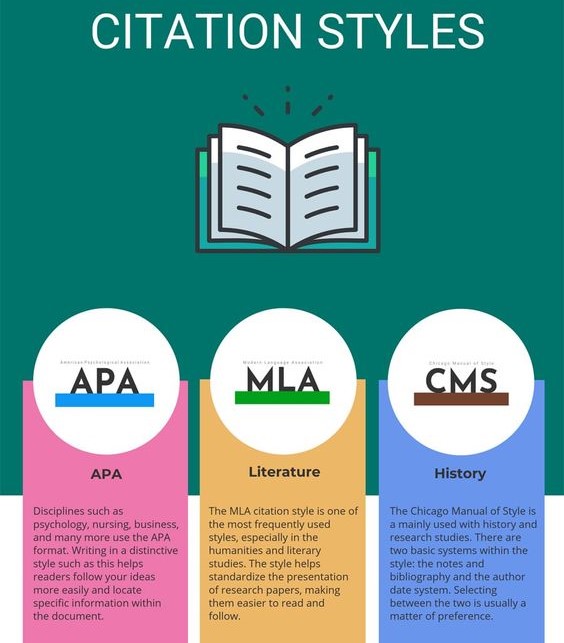
- American Psychological Association (APA) Style: Predominantly used in the social sciences, including nursing, APA emphasizes brevity and consistency.
- Modern Language Association (MLA) Style: Widely used in the humanities, MLA focuses on providing detailed bibliographical information.
- Chicago Manual of Style: Popular in the humanities and social sciences, Chicago offers flexibility in citation formats and provides comprehensive guidelines.
The choice of a research paper citation style usually depends on the specific journal or institution’s requirements. It is essential to consult the submission guidelines carefully to ascertain the preferred research paper citation style.
Navigating the Labyrinth: Mastering the Basics of Citation
Regardless of the chosen citation style, certain fundamental principles remain consistent:
- In-Text Citations: These short citations within the body of your text provide the reader with immediate information about the source of your information. They typically include the author’s name and year of publication.
- Reference List/Bibliography: This comprehensive list at the end of your research paper provides detailed information about all sources cited in your paper. It includes all necessary bibliographic data, such as author names, publication titles, dates, and publishing information.
Unveiling the Secrets: Common Citation Elements
While specific formats might differ slightly across research paper citation styles, certain elements are fundamental:
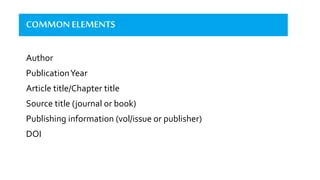
- Author(s): Include the last name(s) and initials of the author(s) as they appear on the source material.
- Year of Publication: The year the source was published. If multiple publications exist for the same year, use letters (a, b, c, etc.) after the year to distinguish them.
- Title of Source: The title of the specific work cited, such as a journal article, book, or website. Titles of books and journals are italicized.
- Publication Information: Depending on the citation style, this may include the journal name, volume number, issue number, page range, publisher, and location of publication.
- Retrieved From (for online sources): The URL or DOI (Digital Object Identifier) of the online source.
The Power of Consistency: Maintaining a Uniform Flow
Consistency is key to a successful research paper citation. Follow these guidelines to ensure a seamless flow throughout your paper:
- Use the same citation style consistently throughout: Avoid switching styles within the same document.
- Maintain a consistent format for author names: If you use the last name followed by initials, stick to this format throughout.
- Be consistent with punctuation and capitalization: Follow the rules of your chosen citation style meticulously.
- Double-check all citations for accuracy: Ensure that all details are correct and match the source material.
Unlocking the Secrets of Specific Sources
Different types of sources require specific citation formats. Here’s a brief overview of the most common:
- Journal Articles: Include author(s), year of publication, article title, journal title (italicized), volume number, issue number (if applicable), and page range.
- Books: Include author(s), year of publication, book title (italicized), edition (if not the first), publisher, and location of publication.
- Websites: Include author(s) or organization (if available), year of publication (if available), title of web page, retrieved from (URL or DOI), and date of access.
- Interviews and Personal Communications: Include name of the interviewee or communicator, type of communication (e.g., email, phone call), and date of communication.
- Images, Tables, and Figures: Include source information, such as author(s), year, title, and publication details.
- Secondary Sources: When citing information found in a secondary source (e.g., a textbook citing a journal article), cite both the primary and secondary sources.
Tools and Resources to Assist Your Journey
The world of research paper citation can feel overwhelming at times, but luckily, numerous tools and resources are available to help you navigate the complexities:
- Citation Management Software: Tools like EndNote, Zotero, and Mendeley allow you to store, organize, and automatically generate citations in your chosen style.
- Online Citation Generators: Websites like EasyBib, Citation Machine, and Cite This For Me can generate citations for various source types, saving you time and effort.
- Style Manuals: The official style manuals (e.g., APA Publication Manual, MLA Handbook) provide comprehensive guidelines and examples for different citation scenarios.
- University Libraries: Many university libraries offer workshops, online tutorials, and dedicated citation librarians to assist students with citation practices.

Mastering the Art of Citation: A Continuous Learning Process
The journey of mastering research paper citation is a continuous learning process. Remember, the key to success lies in:
- Understanding the why behind citation: Embrace the principles of academic honesty and ethical research practices.
- Choosing the right citation style: Follow the requirements of the specific journal or institution.
- Mastering the basics of citation: Become familiar with in-text citations and reference lists.
- Maintaining consistency throughout your paper: Ensure a uniform flow of citations.
- Seeking help when needed: Utilize the available resources and tools to assist you.
Common Mistakes in Research Paper Citation and How to Avoid Them
Even with the best intentions, research paper citations can easily fall prey to common mistakes. These oversights can undermine the credibility of your work, leading to accusations of plagiarism or casting doubt on the validity of your research. Here’s a breakdown of common citation errors and actionable steps to avoid them:
1. Inconsistent Citation Style
- The Mistake: Switching between citation styles within the same paper, creating a chaotic and unprofessional appearance.
- How to Avoid: Select a specific style (APA, MLA, Chicago) and stick to it consistently throughout the entire document.
- Tip: Use a citation management tool to help maintain consistency and avoid errors.
2. Missing or Incomplete Citations
- The Mistake: Omitting essential information (author, year, page number, etc.) or providing incomplete details, leaving readers unable to locate the source.
- How to Avoid: Double-check every research paper citation against the original source for accuracy and completeness.
- Tip: Before submitting, carefully review your citations for any missing or incomplete information.
3. Mismatched In-text and Reference List Entries
- The Mistake: In-text citations do not correspond to the correct entry in the reference list, leading to confusion and potential accusations of plagiarism.
- How to Avoid: Ensure that every in-text citation has a corresponding entry in the reference list and vice versa.
- Tip: Use a citation management tool to automatically generate both in-text and reference list entries.
4. Improper Formatting of References
- The Mistake: Inconsistent formatting of author names, publication dates, journal titles, etc., violating the chosen citation style’s rules.
- How to Avoid: Follow the specific formatting guidelines of the chosen style for each source type (books, articles, websites, etc.).
- Tip: Consult style manuals and online resources for detailed formatting instructions and examples.
5. Citing Secondary Sources without Primary Source Information
- The Mistake: Citing information found in a secondary source (e.g., textbook) without also including the original primary source information.
- How to Avoid: Always cite the original primary source when possible. If the primary source is inaccessible, include both the secondary source and a note indicating the primary source.
- Tip: Use phrases like “as cited in” or “according to” when citing secondary sources.
6. Neglecting to Include Page Numbers for Direct Quotes
- The Mistake: Failing to provide page numbers when directly quoting from a source, leaving the reader unable to locate the exact passage.
- How to Avoid: Include the page number in parentheses after the quote, following the chosen citation style’s guidelines.
- Tip: Always double-check that page numbers are accurate and consistent with the original source.
7. Using Unreliable or Unverified Sources
- The Mistake: Citing sources that lack academic rigor or are known for misinformation, potentially damaging the credibility of your research.
- How to Avoid: Rely on peer-reviewed journal articles, reputable books, and established academic websites as primary sources.
- Tip: Always critically evaluate the source’s credibility, authority, and potential biases.
8. Overuse of Direct Quotes
- The Mistake: Over-relying on direct quotes instead of paraphrasing or summarizing source material, resulting in a paper that lacks original thought.
- How to Avoid: Limit the use of direct quotes to essential passages that cannot be adequately paraphrased.
- Tip: Paraphrase and summarize source material whenever possible, using your own words while still accurately representing the original meaning.
9. Failure to Cite Personal Communications
- The Mistake: Omitting citations for information obtained through personal conversations, emails, or interviews, potentially misrepresenting the origin of your information.
- How to Avoid: Always include a citation for personal communications, including the communicator’s name, type of communication, and date.
- Tip: Be mindful of confidentiality issues when citing personal communications, and always obtain permission before including details that might be considered private.
10. Neglecting to Update References
- The Mistake: Using outdated information or citations without checking for more recent research, potentially missing crucial developments in your field.
- How to Avoid: Regularly update your reference list and ensure all citations are current and relevant to your research topic.
- Tip: Utilize citation management software to alert you to potential updates and new research in your field.
11. Overlooking the Importance of Consistency
- The Mistake: Inconsistent formatting of citations across different types of sources, resulting in an unpolished and unprofessional appearance.
- How to Avoid: Ensure that all citations adhere to the chosen style guide’s formatting rules, regardless of the source type.
- Tip: Use templates or online resources to help maintain consistency across all citations.
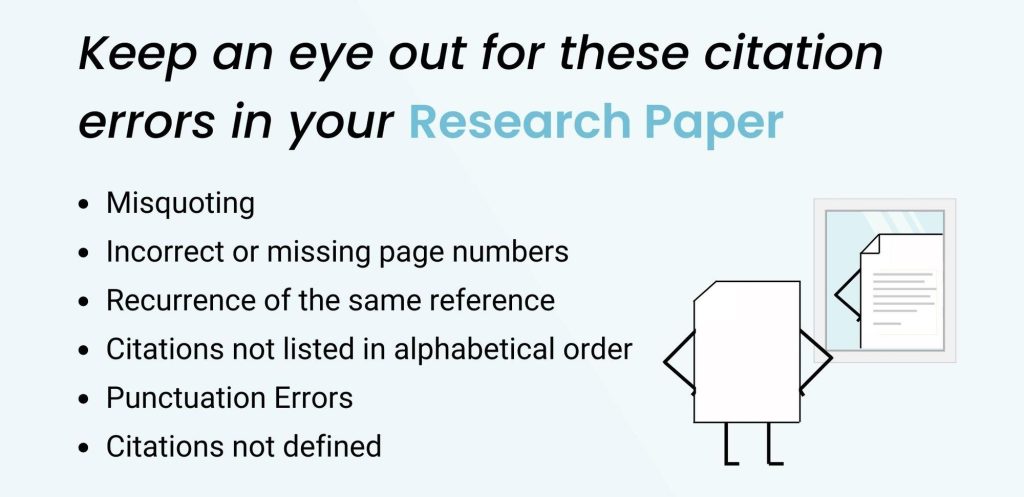
By diligently avoiding these common mistakes, you can ensure your research paper citations are accurate, consistent, and compliant with academic standards. This not only protects your academic integrity but also contributes to the clear and credible dissemination of your research findings.
Remember, a well-crafted research paper citation system is an essential element of sound scholarship. It reflects a commitment to academic honesty, intellectual rigor, and the advancement of knowledge in the field of nursing.
By embracing these practices, you can transform the challenge of research paper citation into a valuable opportunity to demonstrate your academic integrity, credibility, and commitment to sound scholarship. As you navigate the labyrinth of research paper citation, remember that each accurately cited source not only strengthens your argument but also contributes to the collective body of knowledge in the field of nursing.
Get the Best Nursing Research Paper Help
In case you are having difficulties in ensuring proper nursing research paper citation, simply engage our writers at Nursing Papers. We can help you with polishing every aspect of your research paper for excellent results. Our service covers topic suggestion, research paper writing, proof reading, editing, and plagiarism check and removal. We also offer professional assistance with nursing essays, case studies and dissertations






